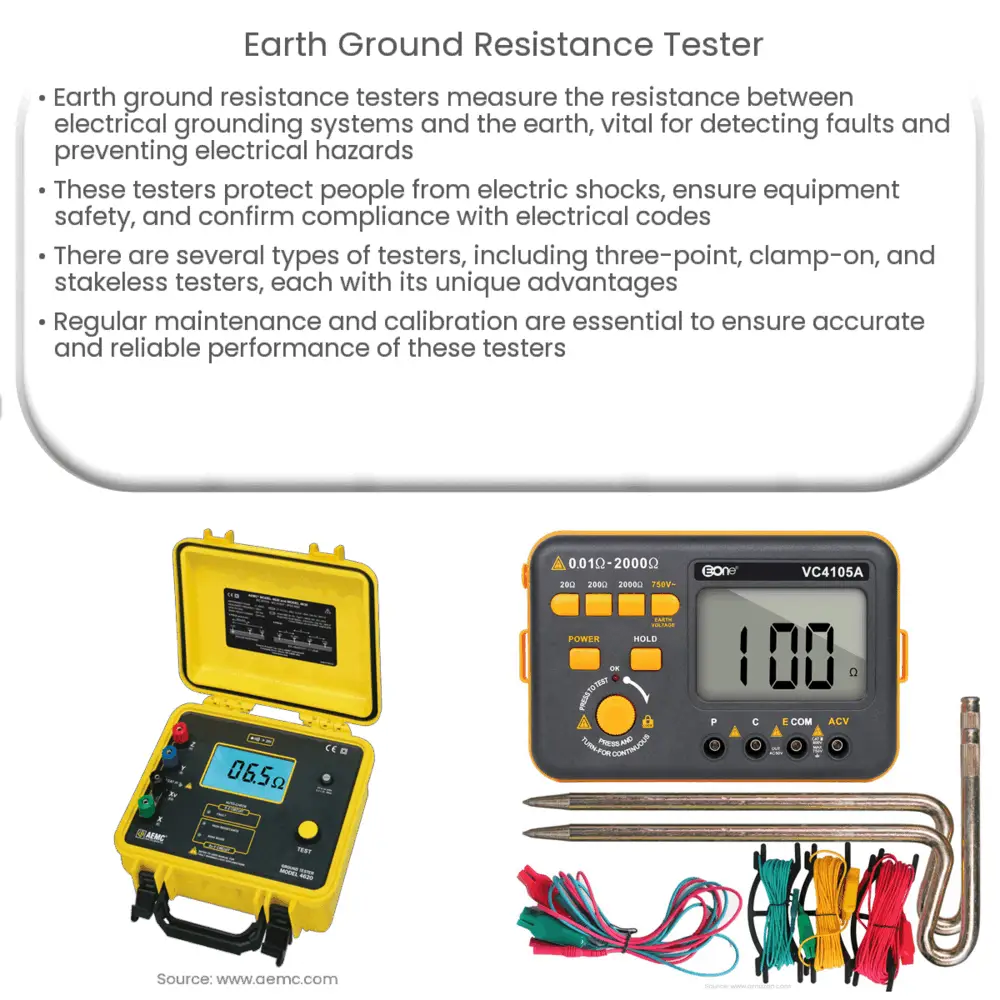An earth ground resistance tester measures the resistance between a grounding system and the earth, ensuring safety and compliance in electrical systems.

Understanding Earth Ground Resistance Testers
Introduction
Earth ground resistance testers are essential instruments used to ensure the safety and efficiency of electrical systems. They measure the resistance between an electrical grounding system and the earth, which is crucial for detecting potential faults and preventing electrical hazards. This article will discuss the principles behind earth ground resistance testing, the importance of this process, and the different types of testers available in the market.
Principles of Earth Ground Resistance Testing
Electrical grounding systems are designed to protect people and equipment from electric shock and other hazards by providing a path for fault current to flow into the earth. The resistance of this path is a critical factor in determining its effectiveness, as high resistance can compromise the system’s ability to dissipate fault current and maintain safe voltage levels.
Earth ground resistance testing involves injecting a known current into the grounding system and measuring the resulting voltage drop across the earth connection. By applying Ohm’s Law, the earth ground resistance can be calculated as:
R = V / I
Where R represents the earth ground resistance, V is the measured voltage drop, and I is the injected current. Accurate measurements are essential to ensure that the grounding system meets safety standards and performs as intended.
Importance of Earth Ground Resistance Testing
Regular earth ground resistance testing is crucial for several reasons:
- Safety: A properly functioning grounding system is vital for protecting people from electric shocks and reducing the risk of fires caused by electrical faults. High earth ground resistance can result in hazardous voltage levels and ineffective fault current dissipation.
- Equipment protection: Grounding systems help to prevent damage to electrical equipment by providing a path for fault current and transient voltages to be safely discharged into the earth. High resistance can compromise this protection, potentially causing costly damage and downtime.
- Compliance: Electrical codes and standards, such as the National Electrical Code (NEC) and the Institute of Electrical and Electronics Engineers (IEEE) guidelines, specify requirements for earth ground resistance levels. Testing ensures that these requirements are met and helps to avoid fines and legal liabilities.
Types of Earth Ground Resistance Testers
There are various types of earth ground resistance testers available, each with its own advantages and limitations. The most commonly used testers include:
- Three-point (Fall-of-Potential) testers: These testers employ a three-electrode method, using a current electrode, a potential electrode, and the grounding electrode under test. They are widely used due to their accuracy and versatility but can be time-consuming to set up.
- Clamp-on testers: Clamp-on testers measure earth ground resistance without the need for auxiliary electrodes, making them quick and easy to use. However, they may be less accurate than three-point testers, especially in systems with multiple ground paths.
- Stakeless testers: These testers use a combination of the clamp-on method and an additional reference electrode, providing increased accuracy without the need for extensive setup. They are suitable for testing multiple ground paths and can be more convenient than traditional three-point testers.
Selecting the appropriate earth ground resistance tester depends on factors such as the complexity of the grounding system, the required accuracy, and the available time and resources for testing.
Choosing the Right Earth Ground Resistance Tester
When selecting an earth ground resistance tester, consider the following factors to make an informed decision:
- Accuracy and resolution: Choose a tester with an accuracy and resolution suitable for your application. While high-precision instruments can provide more accurate results, they may also be more expensive and require additional setup and calibration.
- Test method compatibility: Ensure that the tester supports the desired test method, such as the three-point, clamp-on, or stakeless method, as each method has its own advantages and limitations.
- Measurement range: Select a tester with a measurement range that covers the expected earth ground resistance values for the systems being tested. This ensures that the tester can accurately measure both low and high resistance values.
- Portability and ease of use: Consider the tester’s size, weight, and user interface when selecting a model. Portable and easy-to-use testers can simplify testing procedures and reduce the likelihood of user error.
- Additional features: Some testers offer features such as data logging, GPS integration, and report generation, which can be beneficial for tracking test results and improving documentation.
Maintaining and Calibrating Earth Ground Resistance Testers
Regular maintenance and calibration are essential to ensure the accuracy and reliability of earth ground resistance testers. Follow these best practices to maintain your tester’s performance:
- Inspect and clean: Regularly inspect the tester for any signs of damage or wear and clean it as necessary. This includes checking the leads, probes, and clamps for any signs of corrosion, fraying, or damage.
- Calibrate: Have your earth ground resistance tester calibrated periodically by a qualified service provider to ensure that it meets the manufacturer’s specifications and maintains its accuracy. The recommended calibration interval depends on factors such as usage and environmental conditions but is typically around one year.
- Follow manufacturer guidelines: Always follow the manufacturer’s recommendations for maintenance, storage, and calibration to prolong the life of your tester and ensure accurate measurements.
Conclusion
Earth ground resistance testers are indispensable tools for maintaining the safety and efficiency of electrical grounding systems. By understanding the principles behind earth ground resistance testing, the importance of this process, and the different types of testers available, you can select the right instrument for your needs and ensure that your grounding systems are functioning effectively. Regular maintenance and calibration will help to keep your tester performing at its best and delivering accurate measurements, protecting people and equipment from electrical hazards.

